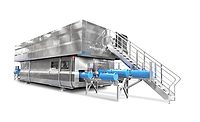Dry Processing Technology
Sorting is no shell game
Caro Nut Company improves product quality, increases yield with Key Technology’s hyperspectral sorter

Caro Nut Company connected a sorter to its plant network, allowing remote help from Key Technology as well as garnering data collection. Photo courtesy of Key Technology
Caro Nut Company, a producer of snacking nuts, nut butters and ingredients for major brands, private label customers and industrial food processors, had been losing good nutmeat to remove the shells during their process. For their nut butter line, the nut company selected Key Technology’s VERYX BioPrint sorter, which combines hyperspectral detection signals with color camera signals at the image pixel level to analyze a richer set of data about the materials it is sorting to improve detection performance and maximize process yield.
Hyperspectral imaging utilizes many wavelengths of information to detect the chemometric and biological properties of objects. Multi-channel, high-resolution color cameras facilitate precise color grading and shape sorting.
“Before we replaced our old sorter, we had to sacrifice a lot of good nutmeat in order to get the shells out. It took a lot of time and effort to re-sort the rejects and recover yield. All that changed with our new sorter,” says Gerard Lorenzano, plant manager at Caro Nut. “This powerful technology has improved our product quality and increased our yield by more than one metric ton of product a day.”
“This powerful technology has improved our product quality and increased our yield by more than one metric ton of product a day.”
—Gerard Lorenzano, plant manager, Caro Nut
Combining hyperspectral imaging with color cameras, the unit inspects across a range of wavelengths within the near infrared spectrum as well as visible light to analyze a richer data set about the materials it is sorting. Data from the hyperspectral sensors and color cameras is fused at the pixel level using Key’s Pixel Fusion technology, producing a unique “signature” for each material substance to detect the chemometric and biologic properties of objects. This nut sorter finds and removes the widest variety of foreign material and even hard-to-detect defects like nuts with insect damage, rot and mold without false rejects, regardless of incoming defect loads, while shape sorting and color grading.
“Detecting shells is difficult for traditional laser/camera sorters because, when shells are the same color as good nut meat, it can trick the sensors,” says Sonny Chhina, maintenance supervisor at Caro Nut. “This sorter is so effective, we’ve eliminated manual inspection on the line and moved that person to elsewhere in our plant.
“We’re able to handle heavier loads of incoming shells and defects with this hyperspectral sorter,” Chhina adds. “We start by selecting the product recipe from the sorter’s memory. If the incoming load is very heavy, we may need to adjust the sensitivity of the settings a little, but that’s easy to do with just a couple of taps on the touchscreen. Then we’re good to go.”
Caro Nut’s new sorter features front- and rear-mounted hyperspectral sensors and high-resolution color cameras. It can sort up to eight metric tons of cashews, almonds, macadamia nuts and other nuts per hour.
The nut producer connected its sorter to its plant network, allowing remote help from Key as well as tapping into data collection. “For example, our sorter is programmed to measure the attributes of the incoming product and its reject stream,” Chhina explains. “We use that information to be sure we’re ejecting exactly what we want to remove. We also give that data to our source managers so they can negotiate supplier payments based on incoming product quality.”
For more information, visit www.key.net.
Looking for a reprint of this article?
From high-res PDFs to custom plaques, order your copy today!









